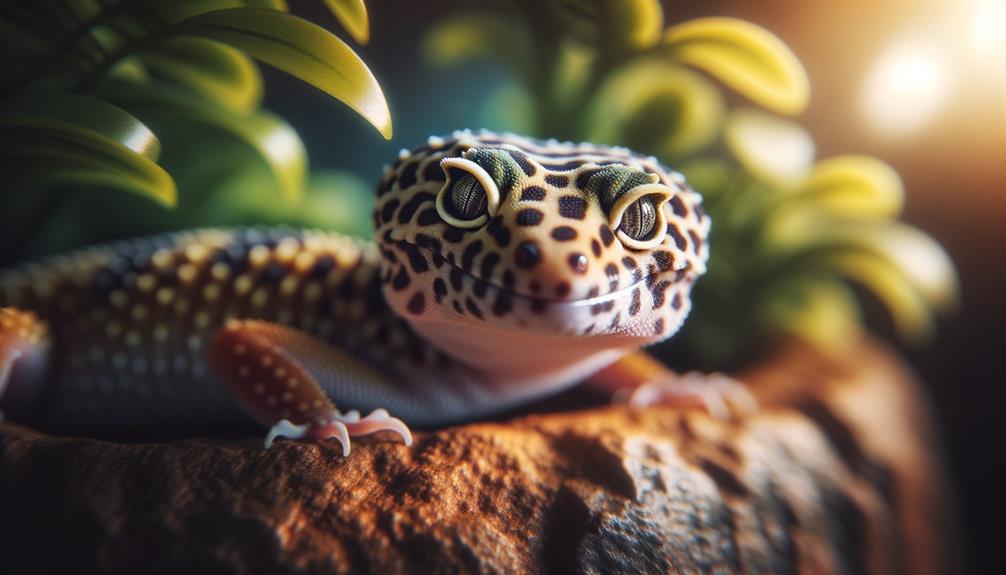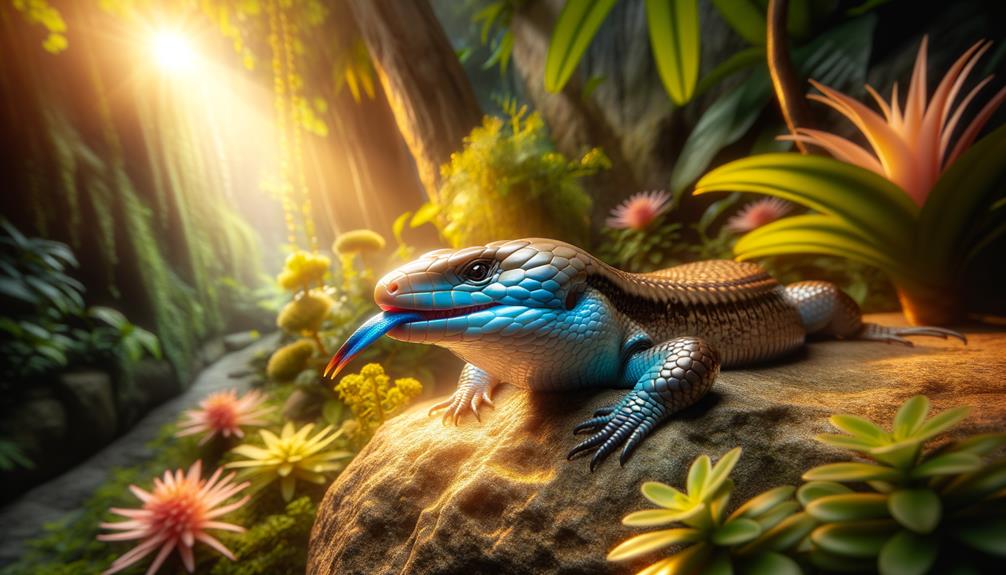I've always been drawn to bearded dragons – they're incredibly charismatic creatures. Hailing from Australia's arid landscapes, they've adapted remarkably, with their color-changing abilities and impressive swimming skills. These reptiles grow from tiny hatchlings into two-foot-long adults, boasting iconic, defensive spines around their 'beards.' Their sensory abilities are remarkable, equipped with vibrant color vision and a unique parietal eye. A well-balanced diet is key to their thriving, and they form complex social hierarchies, even recognizing and bonding with their human caretakers. If you're curious about these fascinating creatures, there's much more to explore.
Key Takeaways
Bearded dragons have a unique ability to change color, which not only adds to their charm but also serves as a vital survival mechanism. Their iconic "beard" – a spiky, pouch-like growth on their chin – is a captivating defense mechanism that helps deter predators. Bearded dragons are known to form strong bonds with their owners, recognizing familiar faces and responding to their presence. With their vibrant color vision and acute hearing, they are highly perceptive and engaging pets. In the wild, bearded dragons display intricate social behaviors, often interacting with each other in complex and dynamic ways.
Origins and Habitat
Bearded dragons, native to Australia's arid regions, have thrived since the time of the dinosaurs, showcasing their remarkable adaptability to their harsh environment. I've always been fascinated by these resilient creatures. In the arid deserts, survival isn't just about finding food and water; it's about mastering the art of adaptation. These dragons inhabit diverse environments, from rocky outcrops to scrublands, each with unique challenges.
One of the most fascinating aspects of their existence is their swimming ability. Despite the unforgiving desert terrain, these dragons can hold their breath for up to two minutes, allowing them to navigate through water when necessary. This ability is a testament to their evolutionary prowess.
Moreover, their ability to change color is not just for show. This remarkable skill helps them blend seamlessly into their surroundings, be it the russet sands of the deserts or the muted tones of scrublands. This color-changing ability is a survival strategy, enabling them to evade predators and hunt more effectively.
In the grand scheme of nature, bearded dragons embody the spirit of resilience and adaptability, thriving in environments where many would struggle to survive. They are a testament to the power of adaptation and their ability to thrive in harsh conditions.
Physical Characteristics
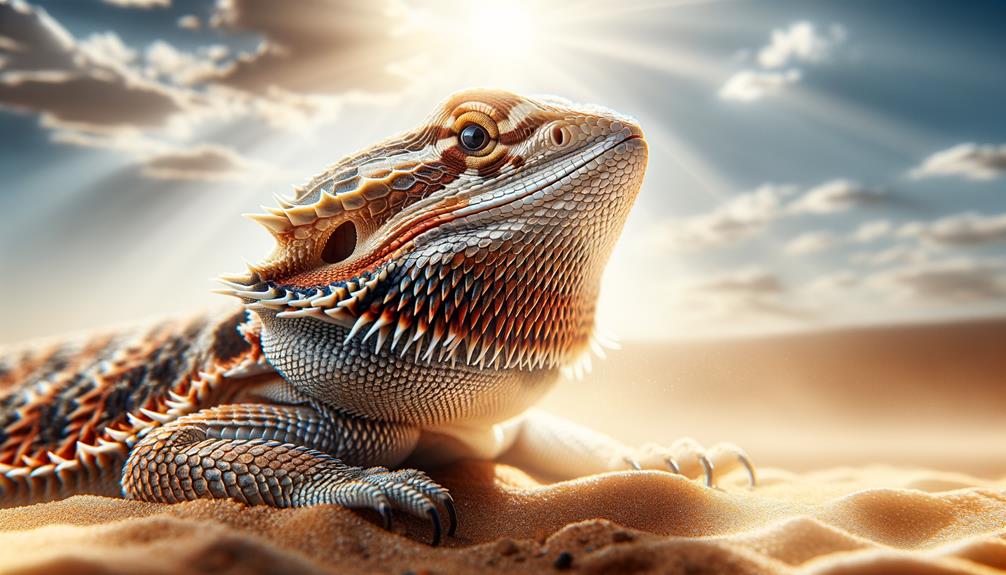
Bearded dragons undergo a remarkable transformation, growing from a tiny size, no bigger than a pinky fingernail, to an impressive two feet in length. This remarkable growth is a testament to their resilience and adaptability.
Their iconic beard-like spines are not just for show; they puff up as a defense mechanism, making the bearded dragons appear larger and more intimidating to potential predators. This clever adaptation is a prime example of how evolution has equipped them with tools for survival.
Bearded dragons are not only visually striking, but they're also physically impressive. They're skilled swimmers, capable of holding their breath for up to two minutes. Some of their notable features include:
- Their remarkable size transformation, from tiny hatchlings to two-foot-long adults.
- Their defensive beard, which puffs up to deter threats.
- Their swimming skills, allowing them to hold their breath underwater.
- Their ability to change color, a unique feature shared by only two lizard species.
- Their parietal eye, which detects movement behind them.
In essence, the physical characteristics of bearded dragons showcase their evolutionary brilliance and adaptive prowess.
Sensory Abilities
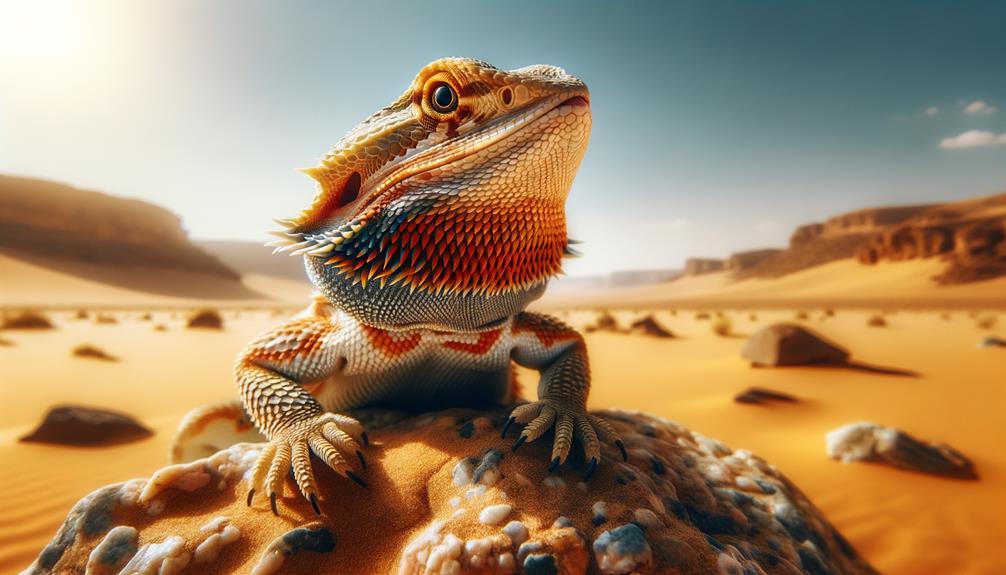
Bearded dragons possess exceptional sensory abilities that enable them to navigate their surroundings with remarkable precision. Their impressive vision allows them to detect even the slightest movement, while their acute hearing picks up subtle sounds. These remarkable senses are further enhanced by a unique parietal eye, a special organ on top of their heads that detects light changes and motion, even from behind.
In their natural habitat and within a bearded dragon tank, these heightened senses come into play. Their vibrant color vision helps them distinguish between prey and potential dangers. Their acute hearing makes them adept predators and survivors in their arid Australian landscapes.
Let's break down how these sensory abilities aid our scaly friends:
| Sensory Ability | Function | Benefit |
|---|---|---|
| Vision | Detects color and movement | Identifies prey and threats |
| Parietal Eye | Senses light changes and motion | Enhances environmental awareness |
| Hearing | Detects subtle sounds | Alerts to predators or prey |
| Sensory Perception | All-encompassing environmental navigation | Guarantees survival and adaptability |
These incredible sensory skills not only showcase their intelligence but also make bearded dragons fascinating companions. Whether in the wild or a bearded dragon tank, their perceptive prowess is truly remarkable.
Diet and Nutrition
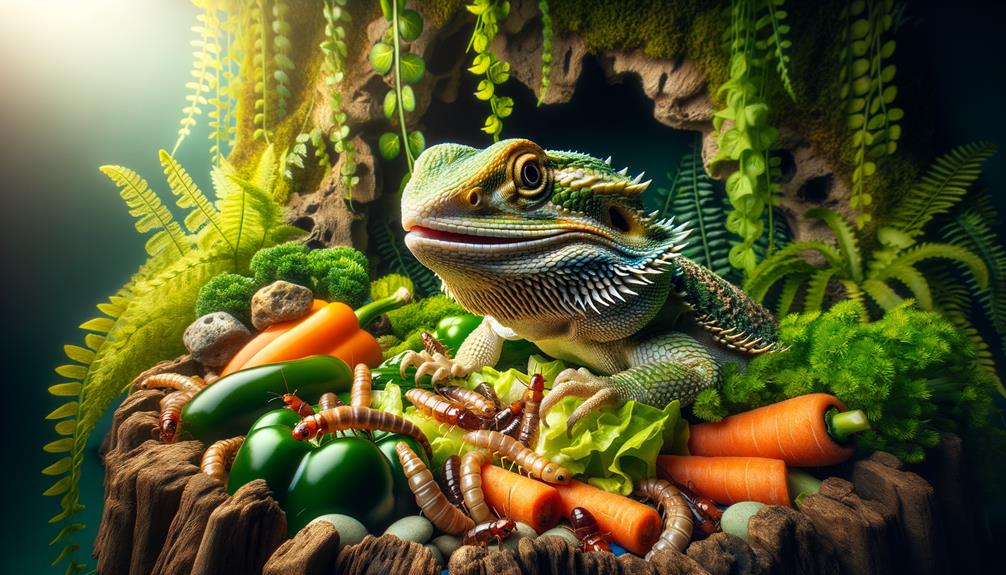
When it comes to feeding bearded dragons, understanding their dietary needs is crucial for their health and well-being. As omnivores, they require a mix of insects, greens, vegetables, and fruits to thrive.
Young bearded dragons need a protein-rich diet, primarily consisting of insects like crickets and mealworms, to support their rapid growth. As they mature, their dietary needs change. Adults require a balanced diet where 60-80% consists of vegetables and greens, such as collard greens, with the remainder being occasional fruits and limited insects.
Dietary Essentials:
- Protein-Rich Start: Young bearded dragons need an insect-heavy diet to support growth.
- Greens and Veggies: Adults require a diet rich in greens like collard greens.
- Supplements: Calcium and vitamin supplements are vital to prevent deficiencies.
- Hydration: Always provide fresh, clean water in a shallow bowl for drinking and soaking.
- Fruit Treats: Offer fruits sparingly due to their high sugar content.
Social Behavior

While a balanced diet is crucial for a bearded dragon's health, understanding their social behavior is equally vital. In the wild, these creatures often live in groups, communicating through unique behaviors like head bobbing, arm waving, and beard puffing. These fascinating rituals provide valuable insights into their social interactions.
One of the most captivating aspects of bearded dragons is their ability to form complex social hierarchies. Dominant individuals assert their status through specific behaviors, and when new dragons are introduced, they engage in a ritual "dance" to establish dominance and group dynamics. This ritual is both a display of their unique social structure and a crucial part of their life.
Moreover, bearded dragons can form strong bonds with their owners. They recognize familiar faces and enjoy interaction and handling. It's clear they make great pets, providing not just companionship but also a glimpse into a small, dynamic social world.
Frequently Asked Questions
How to Tell if a Bearded Dragon Likes You?
I can tell when my bearded dragon has bonded with me because it approaches me confidently, climbs onto my hand, or gently nuzzles me. When it maintains frequent eye contact, bobs its head, or relaxes in my presence, I know it feels comfortable and trusts me.
Do Bearded Dragons Get Emotionally Attached?
Here's a rewritten version of the text:
When I walk into the room, my bearded dragon, Spike, lights up like a firework. Research shows that these fascinating creatures can recognize and respond to their owners, proving they're capable of forming emotional bonds.
What Kind of Personality Do Bearded Dragons Have?
Bearded dragons have curious, friendly personalities. They're generally calm, enjoy basking, and can be quite interactive. I've found they recognize their owners, which makes them fascinating companions for those seeking a unique, low-maintenance pet.
What Is the Rarest Bearded Dragon Morph?
Among bearded dragon enthusiasts, the Silkback morph stands out for its unique appearance. Its smooth, velvety skin sets it apart from other morphs, making it the rarest and most coveted among breeders and owners.


